Additive Manufacturing: Corrosion Proofing by Infusion of Interstitial Solute—Exemplified for Alloy 22
Abstract
1. Introduction
2. Materials and Methods
2.1. Raw Materials
2.2. Raw Material Pre-Treatment
2.3. Corrosion Coupon Preparation
2.4. Low-Temperature Nitrocarburization by Solid-Reagent Pyrolysis
2.5. Critical Crevice-Corrosion Temperature Testing
2.6. Cyclic Potentiodynamic Polarization
3. Results
3.1. Solid-Reagent Pyrolysis LTNC
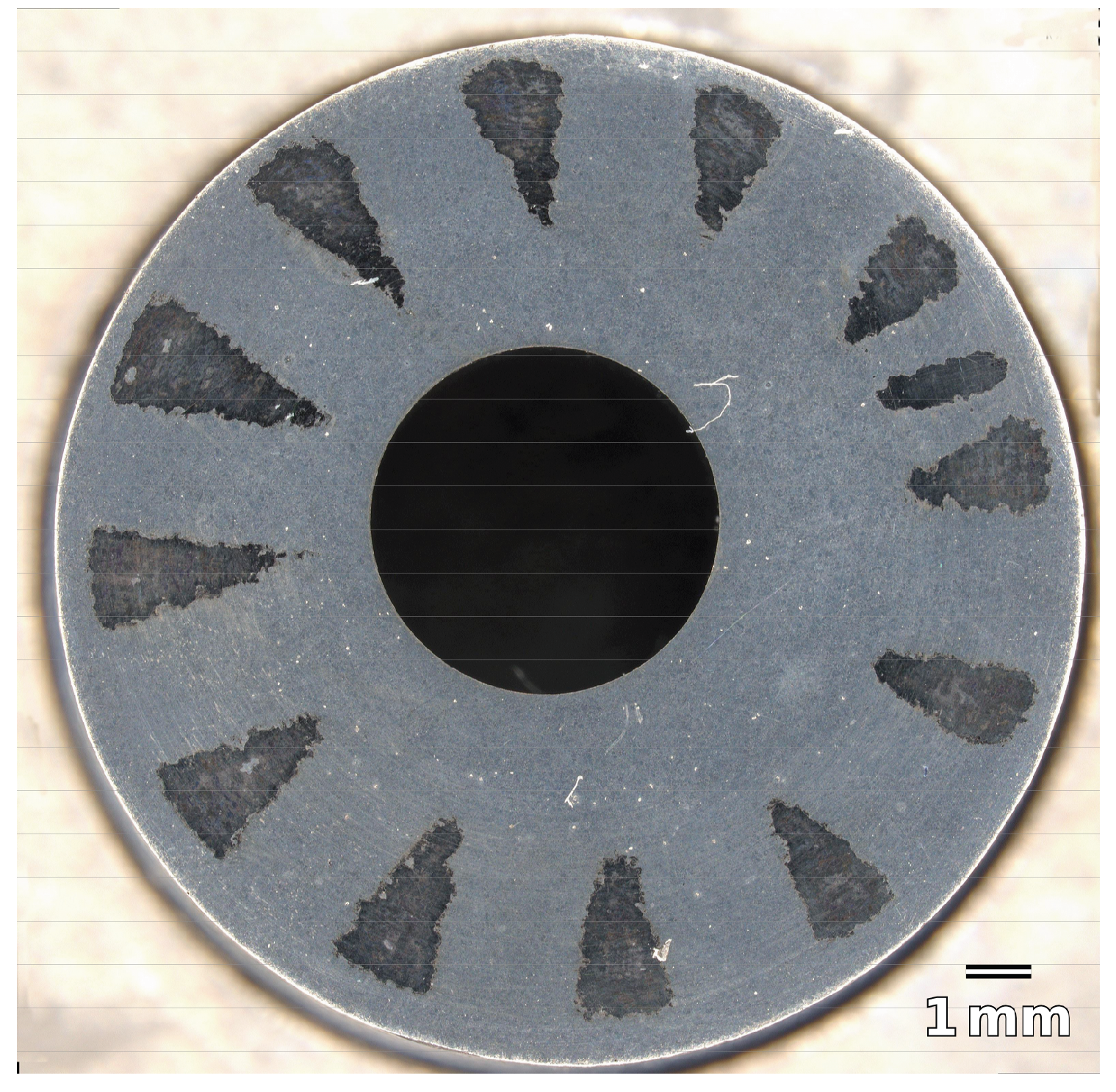
3.2. Critical Crevice-Corrosion Temperature Testing
3.3. Cyclic Potentiodynamic Polarization
4. Discussion
4.1. LTNC by Solid-Reagent Pyrolysis
4.2. Corrosion Resistance
5. Conclusions
- AM (additive manufacturing) has great potential, but AM-made alloys with Cr-based corrosion resistance tend to suffer from high surface roughness, surface-reaching voids, and, consequently, increased susceptibility to corrosion, especially crevice corrosion.
- The properties of alloys containing a significant fraction of Cr can be substantially improved by gas-phase-based infusion of concentrated interstitial solute into a micrometer-scale-deep subsurface zone. This can be applied to finished alloy parts as a scalable post-treatment.
- Gas-phase-based infusion of concentrated interstitial solute can effectively treat alloy surfaces with significant roughness. It works perfectly within crevices and surface-reaching voids. The resulting subsurface zone of concentrated interstitial carbon and nitrogen is highly shape-conformal.
- A particularly potent variant of such surface engineering by infusion of concentrated interstitial solute is LTNC-SRP (low-temperature nitrocarburization by solid-reagent pyrolysis). LTNC-SRP excels on conventional processes for the infusion of concentrated interstitial solute under various aspects, including co-infusion of carbon and nitrogen, reduced processing time, and short-term high-temperature processing.
- A subsurface zone infused with carbon and nitrogen can significantly increase the corrosion resistance of Cr-bearing alloys in chlorine/saltwater environments.
- Therefore, LTNC-SRP is a highly potent method for corrosion proofing of a broad spectrum of Cr-containing AM alloys, such as AISI-316L, IN-718, and 2205.
- For Alloy 22 made by AM, as well as for wrought Alloy 22, LTNC-SRP enables significant improvement of crevice-corrosion resistance. This can enable the application of Alloy 22 in extremely corrosive environments.
- LTNC-SRP performed at a relatively high temperature of 825 K on Alloy 22 not only successfully treats alloy surfaces, but also improves the crevice-corrosion resistance relative to non-treated alloy parts (including wrought Alloy 22).
- Gas-phase-based infusion of concentrated interstitial solute, especially LTNC-SRP, likely provides other significant benefits to AM alloy parts beyond corrosion resistance. Owing to the significant increase in hardness and biaxial compressive stress provided by the infused subsurface zone, it may also bolster AM alloy surfaces against wear and high-cycle fatigue by discouraging surface nucleation and opening of cracks during cyclic mechanical loading.
- The LTNC-SRP process can be tailored to produce desired property profiles.
Author Contributions
Funding
Institutional Review Board Statement
Data Availability Statement
Acknowledgments
Conflicts of Interest
References
- Laleh, M.; Sadeghi, E.; Revilla, R.I.; Chao, Q.; Haghdadi, N.; Hughes, A.E.; Xu, W.; De Graeve, I.; Qian, M.; Gibson, I.; et al. Heat treatment for metal additive manufacturing. Prog. Mater. Sci. 2023, 133, 101051. [Google Scholar] [CrossRef]
- Funch, C.V.; Somlo, K.; Christiansen, T.L.; Somers, M.A. Thermochemical post-processing of additively manufactured austenitic stainless steel. Surf. Coatings Technol. 2022, 441, 128495. [Google Scholar] [CrossRef]
- Montanari, R.; Lanzutti, A.; Richetta, M.; Tursunbaev, J.; Vaglio, E.; Varone, A.; Verona, C. Plasma Carburizing of Laser Powder Bed Fusion Manufactured 316 L Steel for Enhancing the Surface Hardness. Coatings 2022, 12, 258. [Google Scholar] [CrossRef]
- Trelewicz, J.R.; Halada, G.P.; Donaldson, O.K.; Manogharan, G. Microstructure and corrosion resistance of laser additively manufactured 316L stainless steel. Jom 2016, 68, 850–859. [Google Scholar] [CrossRef]
- Sander, G.; Tan, J.; Balan, P.; Gharbi, O.; Feenstra, D.; Singer, L.; Thomas, S.; Kelly, R.; Scully, J.R.; Birbilis, N. Corrosion of additively manufactured alloys: A review. Corrosion 2018, 74, 1318–1350. [Google Scholar] [CrossRef]
- Bajaj, P.; Hariharan, A.; Kini, A.; Kürnsteiner, P.; Raabe, D.; Jägle, E.A. Steels in additive manufacturing: A review of their microstructure and properties. Mater. Sci. Eng. A 2020, 772, 138633. [Google Scholar] [CrossRef]
- Sander, G.; Thomas, S.; Cruz, V.; Jurg, M.; Birbilis, N.; Gao, X.; Brameld, M.; Hutchinson, C. On the corrosion and metastable pitting characteristics of 316L stainless steel produced by selective laser melting. J. Electrochem. Soc. 2017, 164, C250. [Google Scholar] [CrossRef]
- Ziętala, M.; Durejko, T.; Polański, M.; Kunce, I.; Płociński, T.; Zieliński, W.; Łazińska, M.; Stępniowski, W.; Czujko, T.; Kurzydłowski, K.J.; et al. The microstructure, mechanical properties and corrosion resistance of 316 L stainless steel fabricated using laser engineered net shaping. Mater. Sci. Eng. A 2016, 677, 1–10. [Google Scholar] [CrossRef]
- Collins, S.R.; Williams, P.C.; Marx, S.V.; Heuer, A.H.; Ernst, F.; Kahn, H. Low-Temperature Carburization of Austenitic Stainless Steels. In ASM Handbook: Vol. 4D, Heat Treating of Irons and Steels; Dossett, J., Totten, G., Eds.; ASM International: Materials Park, OH, USA, 2014; Volume 4, pp. 451–460. [Google Scholar]
- Michal, G.M.; Ernst, F.; Kahn, H.; Cao, Y.; Oba, F.; Agarwal, N.; Heuer, A.H. Colossal Carbon Supersaturation due to Paraequilibrium Carburization: Stainless Steels with Greatly Improved Mechanical Properties. Acta Mater. 2006, 54, 1597–1606. [Google Scholar] [CrossRef]
- Wu, D.; Ge, Y.; Kahn, H.; Ernst, F.; Heuer, A.H. Diffusion Profiles after Nitrocarburizing Austenitic Stainless Steel. Surf. Coatings Technol. 2016, 279, 180–185. [Google Scholar] [CrossRef]
- Illing, C.; Ren, Z.; Agaponova, A.; Heuer, A.; Ernst, F. Rapid Alloy Surface Engineering through Closed-Vessel Reagent Pyrolysis. Metals 2021, 11, 1764. [Google Scholar] [CrossRef]
- Khorasani, M.; Ghasemi, A.; Leary, M.; Sharabian, E.; Cordova, L.; Gibson, I.; Downing, D.; Bateman, S.; Brandt, M.; Rolfe, B. The effect of absorption ratio on meltpool features in laser-based powder bed fusion of IN718. Opt. Laser Technol. 2022, 153, 108263. [Google Scholar] [CrossRef]
- Illing, C.A. Alloy Surface Engineering by Solid-Reagent Pyrolysis. Ph.D. Thesis, Case Western Reserve University, Cleveland, OH, USA, 2022. [Google Scholar]
- G01 Committee. Test Methods for Pitting and Crevice Corrosion Resistance of Stainless Steels and Related Alloys by Use of Ferric Chloride Solution; Technical Report; ASTM International: Materials Park, OH, USA, 2020. [Google Scholar] [CrossRef]
- Ren, Z.; Heuer, A.H.; Ernst, F. Ultrahigh-strength AISI-316 austenitic stainless steel foils through concentrated interstitial carbon. Acta Mater. 2019, 167, 231–240. [Google Scholar] [CrossRef]
- Ren, Z.; Eppell, S.; Collins, S.; Ernst, F. Co–Cr–Mo alloys: Improved wear resistance through low-temperature gas-phase nitro-carburization. Surf. Coatings Technol. 2019, 378, 124943. [Google Scholar] [CrossRef]
- Li, Z.; Illing, C.; Heuer, A.H.; Ernst, F. Low-Temperature Carburization of AL-6XN Enabled by Provisional Passivation. Metals 2018, 8, 997. [Google Scholar] [CrossRef]
- Dalton, J.C.; Ernst, F.; Heuer, A.H. Low-Temperature Nitridation of 2205 Duplex Stainless Steel. Metall. Mater. Trans. A 2019, 51, 608–617. [Google Scholar] [CrossRef]
- Wu, D.; Kahn, H.; Michal, G.; Ernst, F.; Heuer, A. Ferromagnetism in Interstitially Hardened Austenitic Stainless Steel Induced by Low-Temperature Gas-Phase Nitriding. Scr. Mater. 2011, 65, 1089–1092. [Google Scholar] [CrossRef]
- Sharghi-Moshtaghin, R.; Ge, Y.; Kahn, H.; Gu, X.; Martin, F.; Natishan, P.; Rayne, R.; Michal, G.; Ernst, F.; Heuer, A.H. Low-Temperature Carburization of the Ni-base Superalloy IN718: Improvements in Surface Hardness and Crevice Corrosion Resistance. Metall. Mater. Trans. 2010, 41, 2022–2032. [Google Scholar] [CrossRef]
- Michal, G.M.; Gu, X.; Jennings, W.D.; Kahn, H.; Ernst, F.; Heuer, A.H. Paraequilibrium Carburization of Duplex and Ferritic Stainless Steels. Metall. Mater. Trans. A 2009, 40, 1781–1790. [Google Scholar] [CrossRef]
- Gu, X. Numerical Simulations of Concentration-Depth Profiles of Carbon and Nitrogen in Austenitic Stainless Steel Based upon Highly Concentration Dependent Diffusivities. Ph.D. Thesis, Case Western Reserve University, Cleveland, OH, USA, 2011. [Google Scholar]
- Gu, X.; Michal, G.M.; Ernst, F.; Kahn, H.; Heuer, A.H. Numerical Simulations of Carbon and Nitrogen Composition-Depth Profiles in Nitrocarburized Austenitic Stainless Steels. Metall. Mater. Trans. A 2014, 45, 4268–4279. [Google Scholar] [CrossRef]
- Gu, X.; Michal, G.M.; Ernst, F.; Kahn, H.; Heuer, A.H. Concentration-Dependent Carbon Diffusivity in Austenite. Metall. Mater. Trans. A 2014, 45, 3790–3799. [Google Scholar] [CrossRef]
- Eisinger, N.C.; Shoemaker, L.E. An Explanation of Corrosion Acceptance Tests and Their Applicability to Field Use. In Proceedings of the Corrosion 2007, Nashville, TN, USA, 11–15 March 2007. NACE-07202. [Google Scholar]
- Ernst, F.; Cao, Y.; Michal, G. Carbides in low-temperature-carburized stainless steels. Acta Mater. 2004, 52, 1469–1477. [Google Scholar] [CrossRef]
- Li, T.; Chien, S.C.; Ren, Z.; Windl, W.; Ernst, F.; Frankel, G.S. Understanding the efficacy of concentrated interstitial carbon in enhancing the pitting corrosion resistance of stainless steel. Acta Mater. 2021, 221, 117433. [Google Scholar] [CrossRef]
- Ren, Z. Intrinsic Properties of “Case” and Potential Biomedical Applications. Ph.D. Thesis, Case Western Reserve University, Cleveland, OH, USA, 2019. [Google Scholar]
- Ren, Z.; Ernst, F. Electronic Impact of Concentrated Interstitial Carbon on Physical Properties of AISI-316 Austenitic Stainless Steel. Acta Mater. 2019, 173, 96–105. [Google Scholar] [CrossRef]
- Pistorius, P.C.; Burstein, G.T. Metastable Pitting Corrosion of Stainless Steel and the Transition to Stability. Philos. Trans. Phys. Sci. Eng. 1992, 341, 531–559. [Google Scholar]
- Davis, J.R. Corrosion: Understanding the Basics; ASM International: Materials Park, OH, USA, 2000. [Google Scholar]
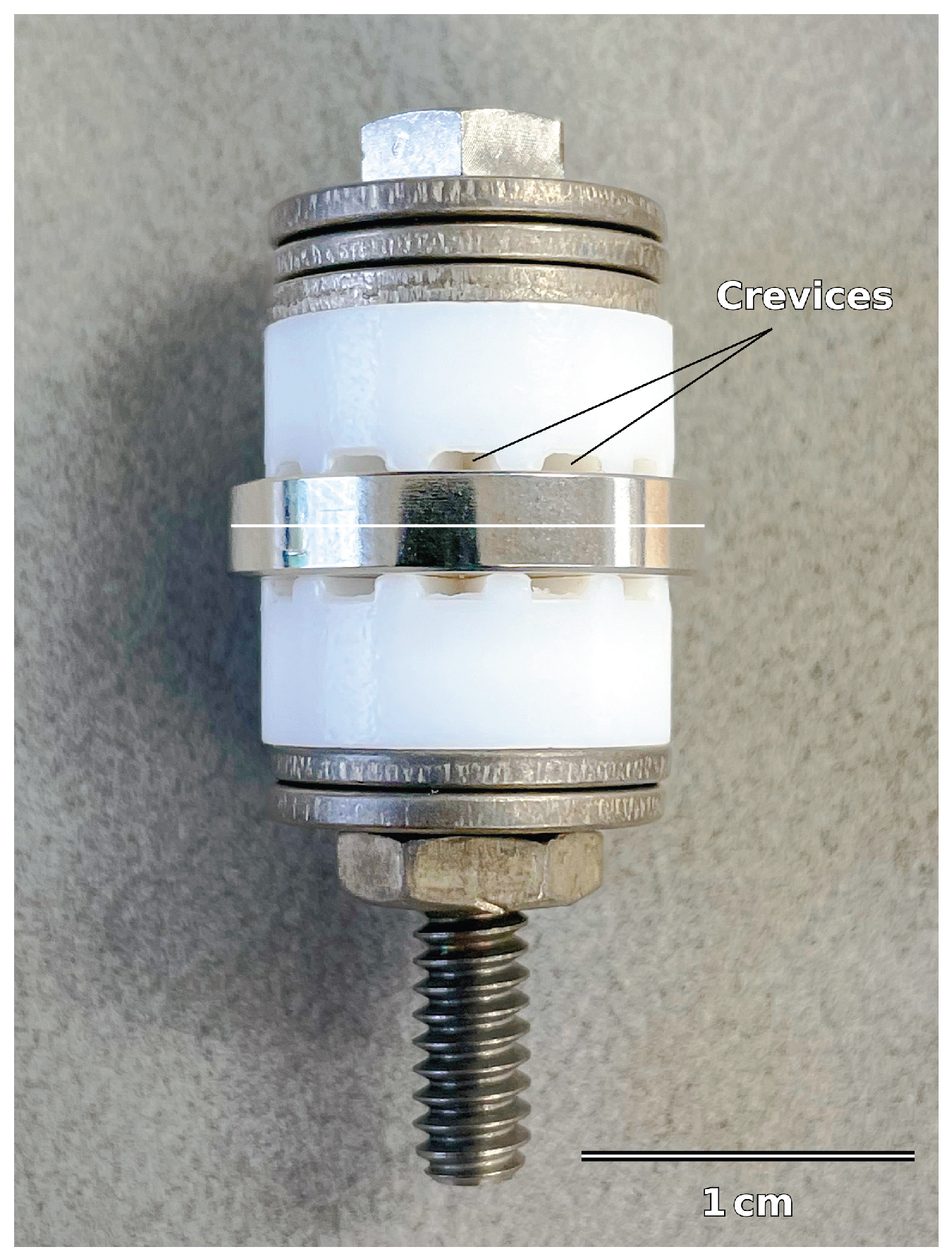
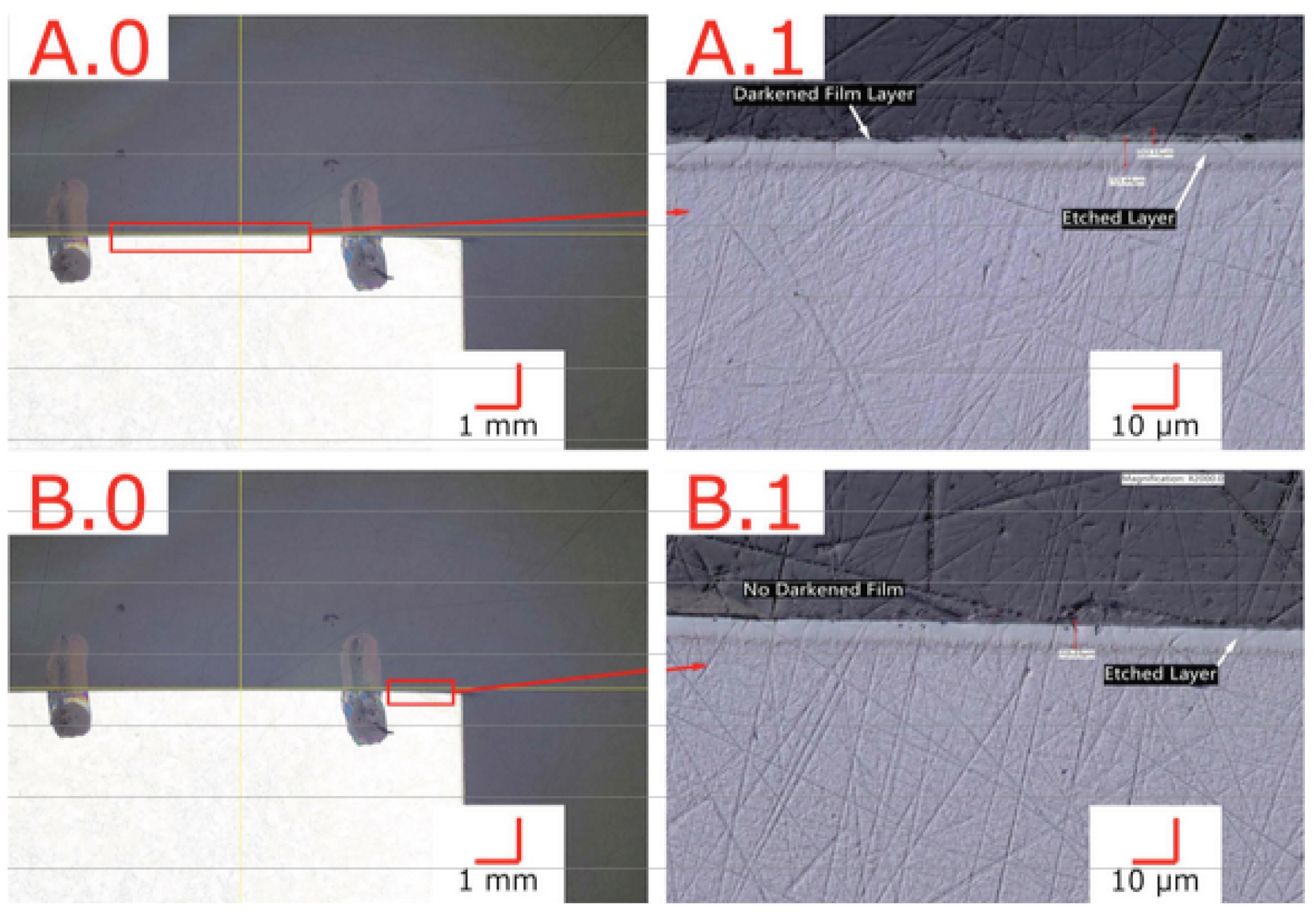
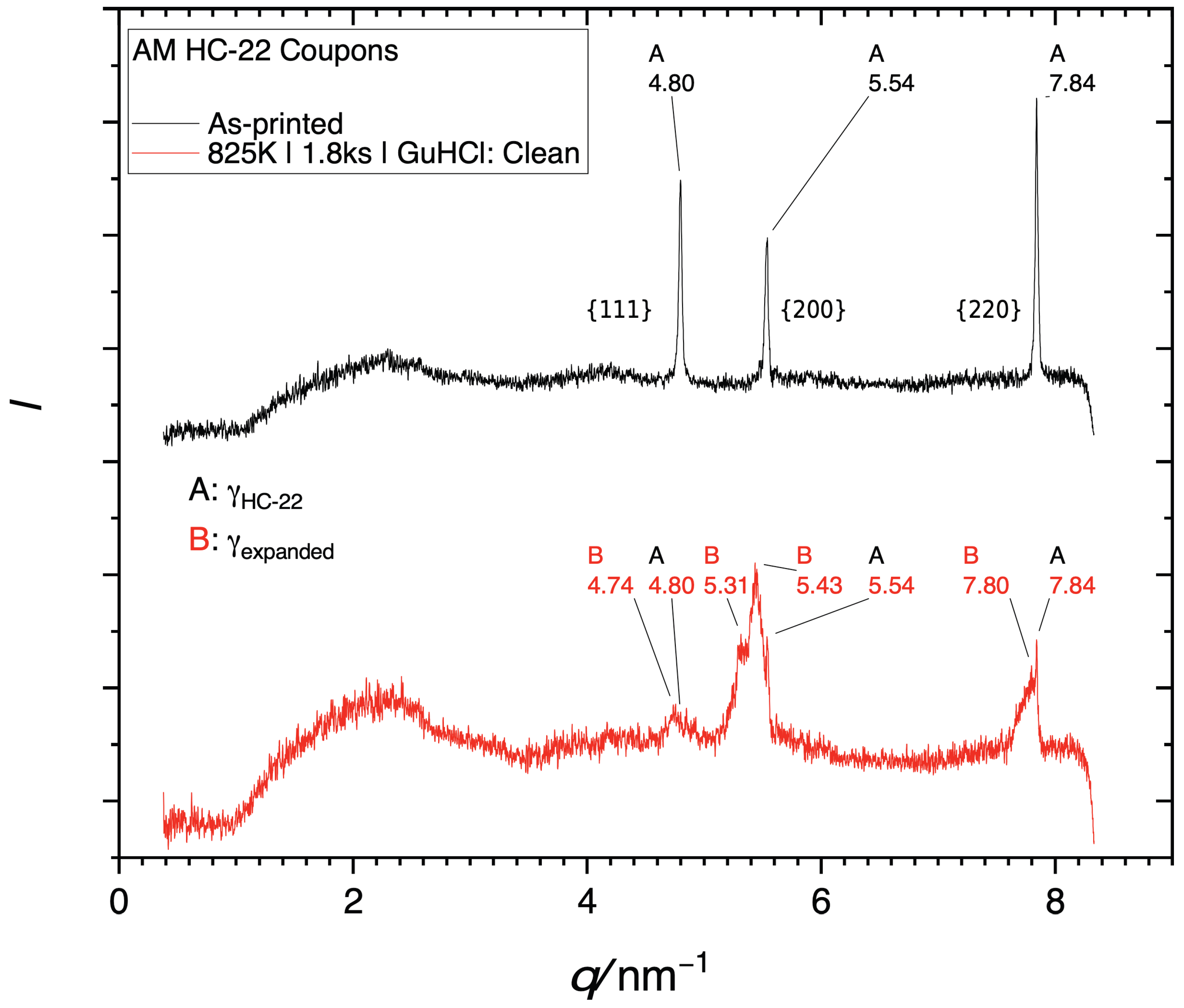
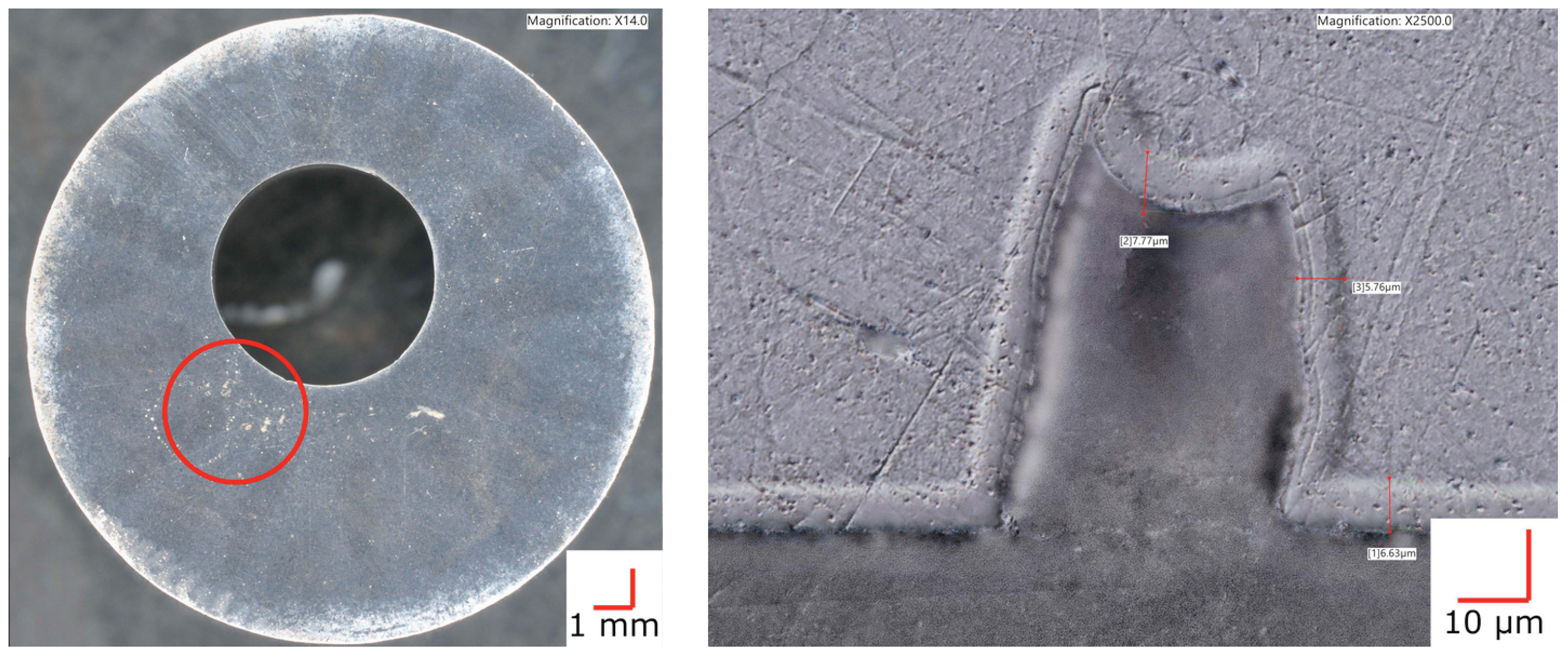
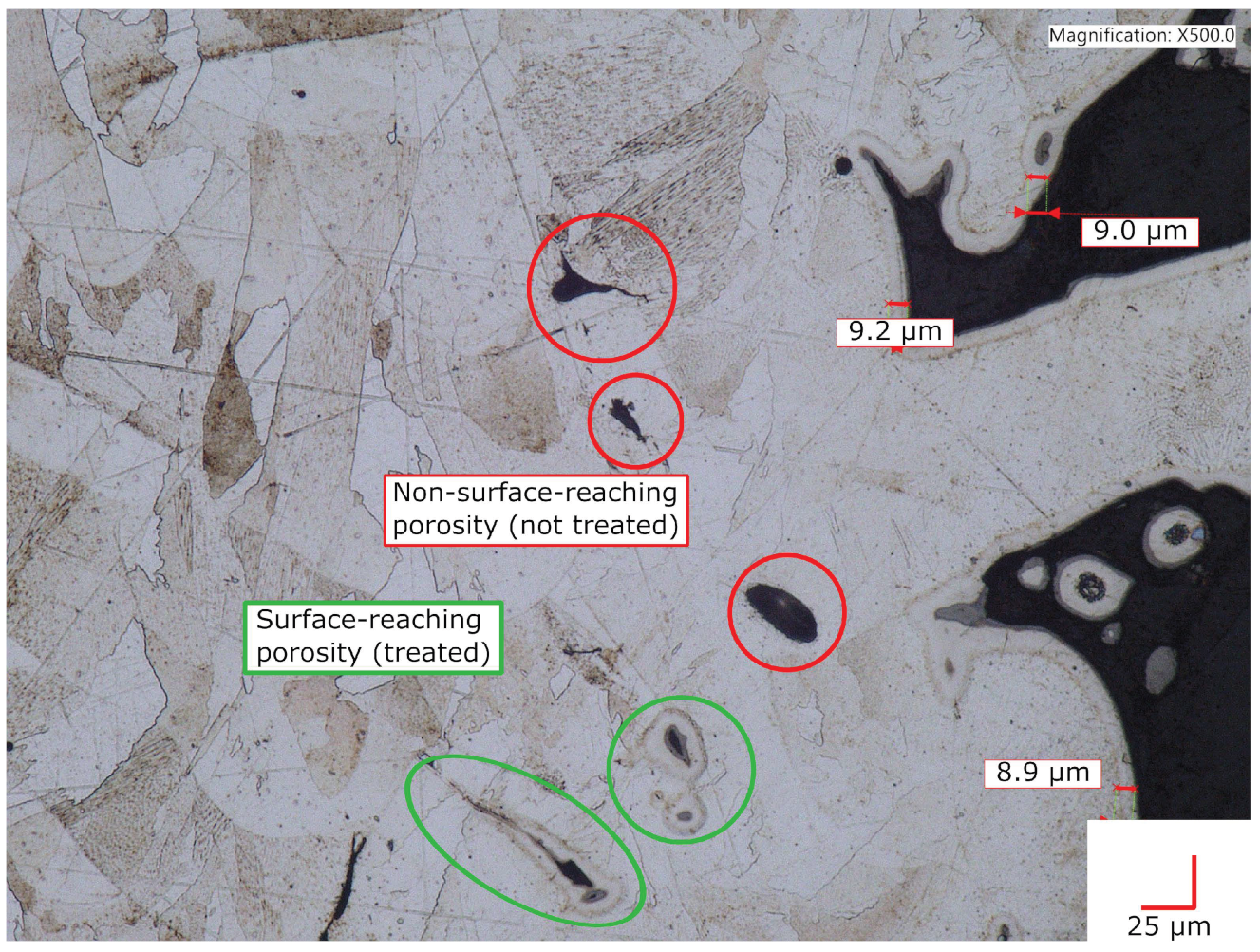

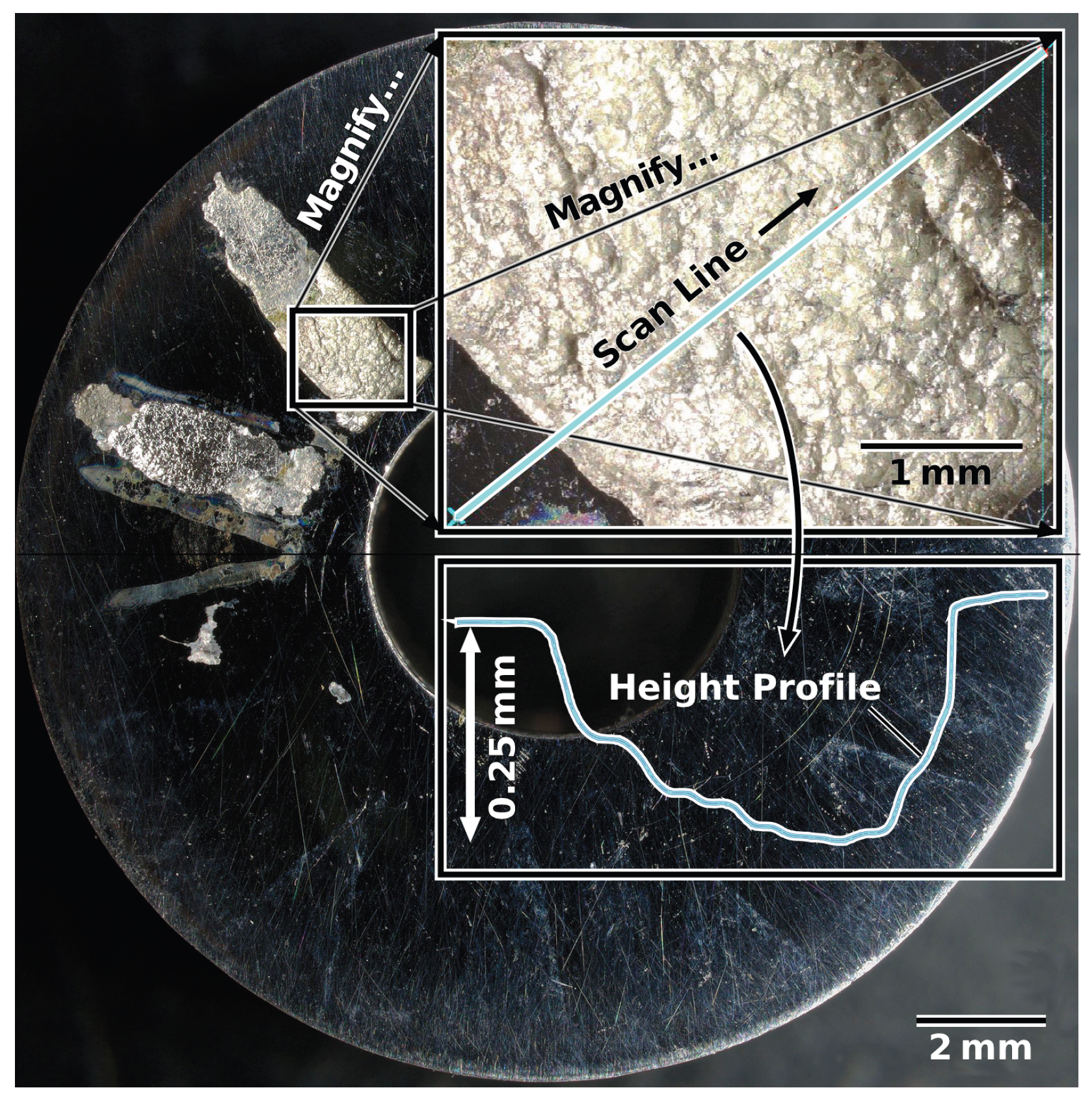

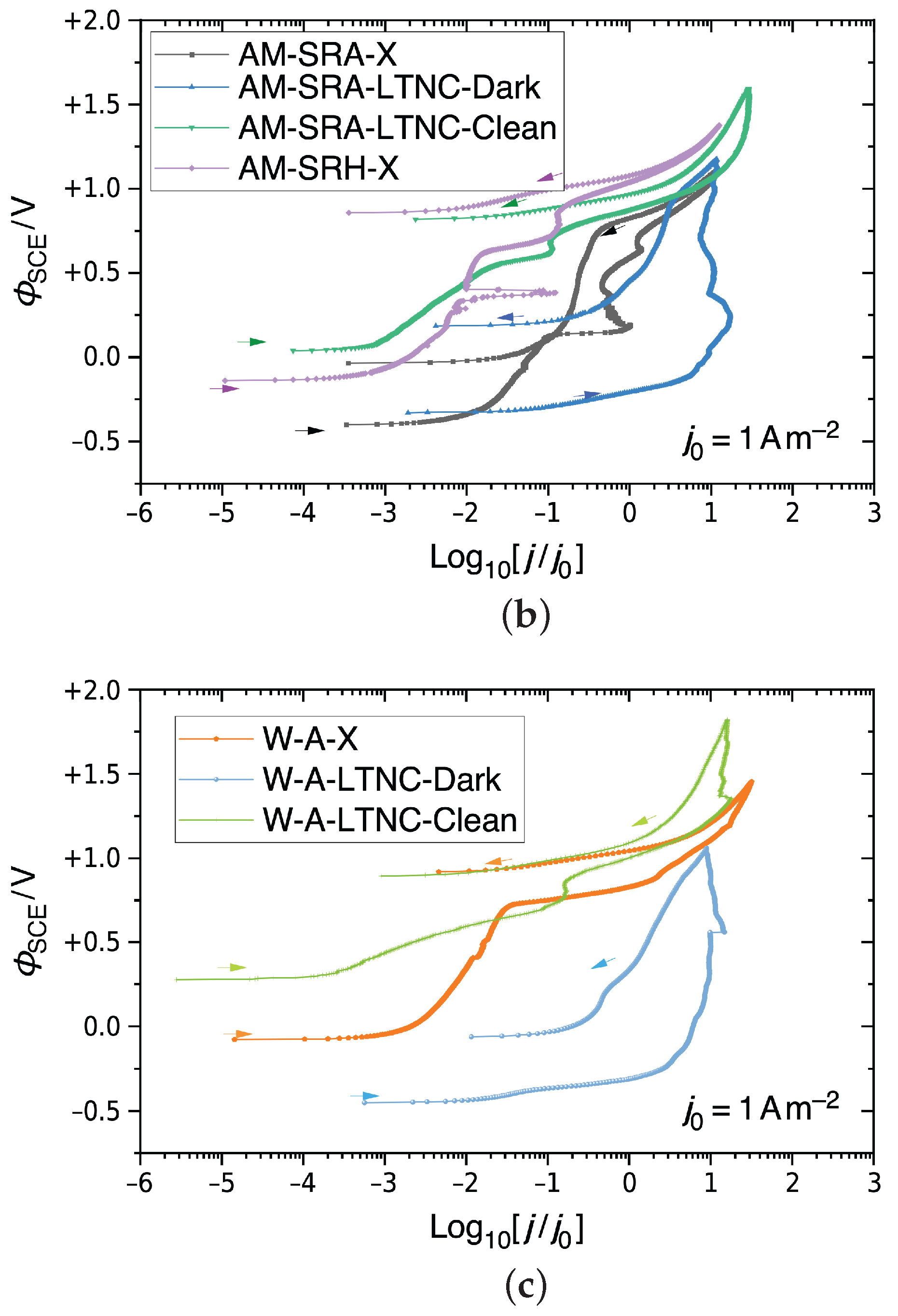
| Material | Fe | Cr | Ni | Mo |
|---|---|---|---|---|
| Wrought | 0.036 | 0.256 | 0.604 | 0.088 |
| LPBF | 0.033 | 0.254 | 0.615 | 0.086 |
| Material | Mn | C | W | Si |
| Wrought | 0.0038 | 0.0002 | 0.01 | 0.0004 |
| LPBF | 0.0001 | 0.0005 | 0.010 | 0.0002 |
| Code | Raw Material |
|---|---|
| W | Wrought Alloy 22. |
| AM | LPBF additively manufactured Alloy 22. |
| Code | Initial Heat Treatment |
| A | Annealed at 1390 K for 3.6 ks, water quenched. |
| SRA | Stress relieved at 1060 K for 21.6 ks. |
| Annealed at 1340 K for 7.2 ks, water quenched. | |
| SRH | Stress relieved at 1060 K for 21.6 ks. |
| Argon HIP-processed at 1450 K for 14.4 ks. | |
| Code | Surface Treatment |
| X | No treatment. |
| LTNC | Low-temperature nitrocarburized by remote |
| solid-reagent pyrolysis. | |
| GuHCl mass per alloy surface area: 250 g/m2 | |
| Heating rate: ≈20 K/min. | |
| Isotherm temperature and time: 825 K, 1.8 ks | |
| Purge: N2 1SLPM. | |
| Code | Sample |
| W-A-X | Wrought Alloy 22: annealed and non-treated. |
| AM-SRA-X | AM Alloy 22: stress-relieved, annealed, and non-treated. |
| AM-SRH-X | AM Alloy 22: stress-relieved, HIP-processed, and non-treated. |
| W-A-LTNC | Wrought Alloy 22: annealed and LTNC-treated. |
| AM-SRA-LTNC | AM Alloy 22: stress-relieved, annealed, and LTNC-treated. |
| AM-SRH-LTNC | AM Alloy 22: stress-relieved, HIP-processed, and LTNC-treated. |
| Sample Type | Critical Crevice Temperature (K) | |||||
|---|---|---|---|---|---|---|
| W-A-X | ≤348 | ≤348 | ≤348 | ≤348 | ≤348 | 348 |
| AM-SRA-X | ≤348 | 353 | 353 | 353 | 353 | 358 |
| AM-SRH-X | ≤343 | 348 | 348 | 348 | 353 | 353 |
| W-A-LTNC | >358 | >358 | >358 | >358 | >358 | >358 |
| AM-SRA-LTNC | >358 | >358 | >358 | >358 | >358 | >358 |
| AM-SRH-LTNC | >358 | >358 | >358 | >358 | >358 | >358 |
Disclaimer/Publisher’s Note: The statements, opinions and data contained in all publications are solely those of the individual author(s) and contributor(s) and not of MDPI and/or the editor(s). MDPI and/or the editor(s) disclaim responsibility for any injury to people or property resulting from any ideas, methods, instructions or products referred to in the content. |
© 2023 by the authors. Licensee MDPI, Basel, Switzerland. This article is an open access article distributed under the terms and conditions of the Creative Commons Attribution (CC BY) license (https://creativecommons.org/licenses/by/4.0/).
Share and Cite
Illing, C.; Bestic, M.; Ernst, F. Additive Manufacturing: Corrosion Proofing by Infusion of Interstitial Solute—Exemplified for Alloy 22. Metals 2023, 13, 127. https://doi.org/10.3390/met13010127
Illing C, Bestic M, Ernst F. Additive Manufacturing: Corrosion Proofing by Infusion of Interstitial Solute—Exemplified for Alloy 22. Metals. 2023; 13(1):127. https://doi.org/10.3390/met13010127
Chicago/Turabian StyleIlling, Cyprian, Michael Bestic, and Frank Ernst. 2023. "Additive Manufacturing: Corrosion Proofing by Infusion of Interstitial Solute—Exemplified for Alloy 22" Metals 13, no. 1: 127. https://doi.org/10.3390/met13010127
APA StyleIlling, C., Bestic, M., & Ernst, F. (2023). Additive Manufacturing: Corrosion Proofing by Infusion of Interstitial Solute—Exemplified for Alloy 22. Metals, 13(1), 127. https://doi.org/10.3390/met13010127







